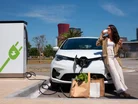Are Bi-Directional EVs Becoming Futuristic Grid Assets?

As EV continue to shape the world of vehicles, is the integration of Vehicle-to-Grid (V2G) the new way forward?
V2G technology offers transformative potential for the energy grid and the vehicle owners.
The concept behind bi-directional EVs is that power will be drawn from the grid but also returned to it, essentially making EVs ‘mobile batteries’.
This notion aligns with the broader trend of Vehicle-to-Everything (V2X) technology, which encompasses various forms of bi-directional energy exchange.
Bi-directional EV growth
An increasing amount of battery electric vehicles (BEVs) now offer discharge of power through V2X technology, including V2G, vehicle-to-home (V2H) and vehicle-to-load (V2L).
The difference between these being:
- V2G: This allows EVs to send power back to the electricity grid, helping balance energy demands and potentially earning money for EV owners.
- V2H: EVs can power homes during outages or supply electricity during peak hours to reduce grid reliance.
- V2L: This enables EVs to power appliances, tools, or even other vehicles, essentially serving as a mobile power bank.
Many car manufacturers are working on V2G production, including Nissan, Volkswagen (VW) and Polestar 3.
From IDTechEx’s report, Shazan Siddiqi writes: “As more automakers embrace V2X technology, vehicles like Ford’s F-150 Lightning and GM’s Silverado are extending the potential of BEVs beyond transport, enhancing grid resilience and offering backup power solutions."
With the properties of EV emerging and becoming more prevalent, moving to more sustainable transport via bi-directional charging include many benefits:
- Emergency power source: EVs can serve as backup power for homes during outages
- Grid stability: V2G technology can help balance energy demands and support grid reliability
- Cost savings: EV owners may save money by charging during off-peak hours and selling energy back to the grid during peak times
- Portable power: V2L functionality allows EVs to power appliances or tools in remote locations.
There are two main approaches to V2X that differ based on location of the inverter in relation to the vehicle and the charging point.
The inverter can be located internally within the EV so that the vehicle discharges in alternating current (AC) to the charger or externally to the vehicle and located within the charger so the vehicle discharges through direct current (DC).
DC V2G systems currently offer a higher discharge rate, providing lower vehicle power but higher infrastructure costs.
The future of V2G
As the amount of V2G BEVs grow, the potential impact on the grid could be significant.
IDTechEx’s report expects: “The annual share of V2X (bidirectional) capable light-duty EVs sold to grow from 5% in 2023 to over 20% by 2028 in the US.”
By spreading the availability of V2G, EVs can contribute to a more flexible energy system.
The co-operation of the automotive and energy sectors has a huge influence on whether this widespread operation can occur.
Energy providers will need to develop effective pricing models and infrastructure that support V2G’s fluctuating energy demands, while vehicle manufacturers must continue developing affordable V2G-compatible vehicles.
Heavy-duty vehicles such as buses, coaches and lorries provide predictable usage patterns and downtime with high-capacity EV batteries, warranting the ability to benefit from V2X.
Volkswagen electric
With climate change being one of the biggest challenges of our time, VW's all-electric ID range of EV vehicles embodies the vision to cut C02 emissions and create a sustainable future.
This first all-electric Volkswagen, the Elektro Transporter, began testing in 1972 – it had a range of 43.5 miles, a top speed of 43.5 miles per hour and could charge to full in 10 hours from the ordinary plug socket in your house.
More recently, the new ID.3, based on Volkswagen’s revolutionary modular electric drive matrix (MEB) platform, has an impressive tested range of 205 - 336 miles.
VW provide a range of help when investing in a climate-saving EV:
- A range simulate to predict how far will the electric battery take the buyer
- A savings calculator to work out running costs and savings
- A step-by-step guide on how to drive the EV
- A Carbon Offset Tool to measure emissions and calculate offset cost.
Dr Adolf Kalberlah led the now-legendary initiative at VW with his background as an electro-chemist and specialist in the field of battery research.
With this revolutionary start up, Adolf commented: "We were the leaders in the application of batteries in vehicles... we believed in electric drive technology."
As advancements continue and standardisation progresses, V2G technology could soon become mainstream, enabling EV owners to actively participate in the energy ecosystem and carbon emission combat.
Make sure you check out the latest edition of EV Magazine and also sign up to our global conference series - Sustainability LIVE 2024 & Manufacturing & Mobility LIVE 2025
EV Magazine is a BizClik brand

